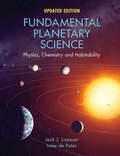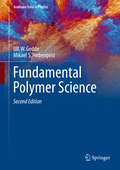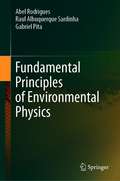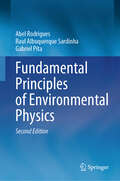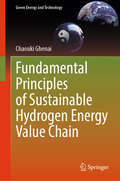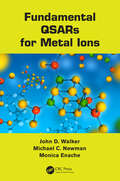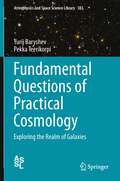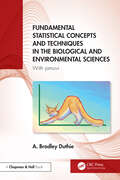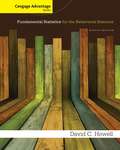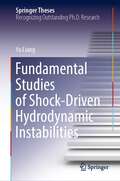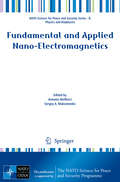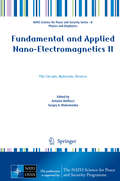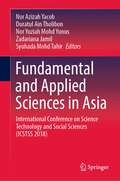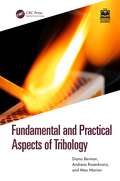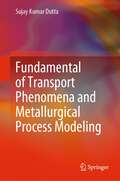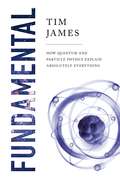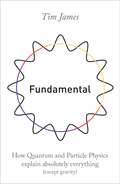- Table View
- List View
Fundamental Neuroscience, Second Edition
by Larry R. Squire James L. Roberts Nicholas C. Spitzer Michael J. Zigmond Susan K. Mcconnell Floyd E. BloomA definitive text in neuroscience.
Fundamental Physics and Physics Education Research (Springer Proceedings In Physics Ser. #145)
by Burra G. Sidharth Marisa Michelini Jesús Carnicer Murillo Carmen PereaThis book highlights selected contributions presented at the 15th annual international symposium Frontiers of Fundamental Physics (FFP15), with the aim of informing readers about the most important recent advances in fundamental physics and physics education research. The FFP series offers a platform for physicists from around the world to present their latest theories and findings. The latest symposium was held in Orihuela, Spain and covered diverse fields of research, including gravitation, astronomy and astrophysics, physics of complex systems, high-energy physics, and mathematical physics. Considerable attention was also paid to physics education research, teacher education in physics, and the popularization of physics. In a knowledge-based society, research into fundamental physics plays a vital role in both the advancement of human knowledge and the development of new technologies. Presenting valuable new peer-reviewed contributions submitted from 15 countries, this book will appeal to a broad audience of scholars and researchers.
Fundamental Physics in Particle Traps
by Wolfgang Quint Manuel VogelThis volume provides detailed insight into the field of precision spectroscopy and fundamental physics with particles confined in traps. It comprises experiments with electrons and positrons, protons and antiprotons, antimatter and highly charged ions together with corresponding theoretical background. Such investigations represent stringent tests of quantum electrodynamics and the Standard model, antiparticle and antimatter research, test of fundamental symmetries, constants and their possible variations with time and space. They are key to various aspects within metrology such as mass measurements and time standards, as well as promising to further developments in quantum information processing. The reader obtains a valuable source of information suited for beginners and experts with an interest in fundamental studies using particle traps.
Fundamental Planetary Science: Physics, Chemistry and Habitability
by Imke De Pater Jack J. LissauerA quantitative introduction to the Solar System and planetary systems science for advanced undergraduate students, this engaging new textbook explains the wide variety of physical, chemical and geological processes that govern the motions and properties of planets. The authors provide an overview of our current knowledge and discuss some of the unanswered questions at the forefront of research in planetary science and astrobiology today. They combine knowledge of the Solar System and the properties of extrasolar planets with astrophysical observations of ongoing star and planet formation, offering a comprehensive model for understanding the origin of planetary systems. The book concludes with an introduction to the fundamental properties of living organisms and the relationship that life has to its host planet. With more than 200 exercises to help students learn how to apply the concepts covered, this textbook is ideal for a one-semester or two-quarter course for undergraduate students.
Fundamental Planetary Science: Physics, Chemistry and Habitability
by Jack J. Lissauer Imke de PaterA quantitative introduction to the Solar System and planetary systems science for advanced undergraduate students, this engaging textbook explains the wide variety of physical, chemical and geological processes that govern the motions and properties of planets. The authors provide an overview of our current knowledge and discuss some of the unanswered questions at the forefront of research in planetary science and astrobiology today. This updated edition contains the latest data, new references and planetary images and an extensively rewritten chapter on current research on exoplanets. The text concludes with an introduction to the fundamental properties of living organisms and the relationship that life has to its host planet. With more than 200 exercises to help students learn how to apply the concepts covered, this textbook is ideal for a one-semester or two-quarter course for undergraduate students.
Fundamental Polymer Science (Graduate Texts in Physics)
by Ulf W. Gedde Mikael S. HedenqvistThis successor to the popular textbook, “Polymer Physics” (Springer, 1999), is the result of a quarter-century of teaching experience as well as critical comments from specialists in the various sub-fields, resulting in better explanations and more complete coverage of key topics. With a new chapter on polymer synthesis, the perspective has been broadened significantly to encompass polymer science rather than “just” polymer physics. Polysaccharides and proteins are included in essentially all chapters, while polyelectrolytes are new to the second edition. Cheap computing power has greatly expanded the role of simulation and modeling in the past two decades, which is reflected in many of the chapters. Additional problems and carefully prepared graphics aid in understanding. Two principles are key to the textbook’s appeal: 1) Students learn that, independent of the origin of the polymer, synthetic or native, the same general laws apply, and 2) students should benefit from the book without an extensive knowledge of mathematics. Taking the reader from the basics to an advanced level of understanding, the text meets the needs of a wide range of students in chemistry, physics, materials science, biotechnology, and civil engineering, and is suitable for both masters- and doctoral-level students. Praise for the previous edition: ...an excellent book, well written, authoritative, clear and concise, and copiously illustrated with appropriate line drawings, graphs and tables. - Polymer International ...an extremely useful book. It is a pleasure to recommend it to physical chemists and materials scientists, as well as physicists interested in the properties of polymeric materials. - Polymer News This valuable book is ideal for those who wish to get a brief background in polymer science as well as for those who seek a further grounding in the subject. - Colloid Polymer Science The solutions to the exercises are given in the final chapter, making it a well thought-out teaching text. - Polymer Science
Fundamental Principles of Environmental Physics
by Abel Rodrigues Raul Albuquerque Sardinha Gabriel PitaThis book is an interdisciplinary and accessible guide to environmental physics. It allows readers to gain a more complete understanding of physical process and their interaction with ecological ones underpin important environmental issues.The book covers a wide range of topics within environmental physics, including:• natural and anthropogenic canopies, including forests, urban or wavy terrains;• the fundamentals of heat transfer;• atmospheric flow dynamics;• global carbon budget;• climate change; and• the relevance of biochar as a global carbon sink.Including solved exercises, numerous illustrations and tables, as well as an entire chapter focused on applications, book is of interest to researchers, students and industrial engineers alike.
Fundamental Principles of Environmental Physics
by Abel Rodrigues Gabriel Pita Raul Albuquerque SardinhaThis book is an interdisciplinary guide to environmental physics grounded in sound mathematical formulation. Its holistic approach allows readers to gain a more complete understanding of physical processes and their interactions with ecological ones, which underpin important environmental issues. The primary focus is on the atmospheric surface layer and topsoil layers. This book interests researchers, students, agronomists, foresters, and urbanist engineers alike. The book covers a wide range of topics within environmental physics, including: • natural and anthropogenic canopies, including forests, urban or wavy terrains; • fundamentals of heat and mass transfer; • atmospheric flow dynamics; • eddy covariance and aerodynamic approaches for quantification of atmospheric fluxes; • global carbon budget; • soil-water relationships; • climate change; and • the relevance of biochar as a global carbon sink. Each chapter includes solved exercises, numerous illustrations, and tables. This refreshed and updated edition also contains a new chapter on soil-water relationships.
Fundamental Principles of Nuclear Engineering
by Jiyang YuThis book highlights a comprehensive and detailed introduction to the fundamental principles related to nuclear engineering. As one of the most popular choices of future energy, nuclear energy is of increasing demand globally. Due to the complexity of nuclear engineering, its research and development as well as safe operation of its facility requires a wide scope of knowledge, ranging from basic disciplines such as mathematics, physics, chemistry, and thermodynamics to applied subjects such as reactor theory and radiation protection. The book covers all necessary knowledge in an illustrative and readable style, with a sufficient amount of examples and exercises. It is an easy-to-read textbook for graduate students in nuclear engineering and a valuable handbook for nuclear facility operators, maintenance personnel and technical staff.
Fundamental Principles of Polymeric Materials
by Christopher S. Brazel Stephen L. RosenNew edition brings classic text up to date with the latest science, techniques, and applicationsWith its balanced presentation of polymer chemistry, physics, and engineering applications, the Third Edition of this classic text continues to instill readers with a solid understanding of the core concepts underlying polymeric materials. Both students and instructors have praised the text for its clear explanations and logical organization. It begins with molecular-level considerations and then progressively builds the reader's knowledge with discussions of bulk properties, mechanical behavior, and processing methods.Following a brief introduction, Fundamental Principles of Polymeric Materials is divided into four parts:Part 1: Polymer FundamentalsPart 2: Polymer SynthesisPart 3: Polymer PropertiesPart 4: Polymer Processing and PerformanceThoroughly Updated and RevisedReaders familiar with the previous edition of this text will find that the organization and style have been updated with new material to help them grasp key concepts and discover the latest science, techniques, and applications. For example, there are new introductory sections on organic functional groups focusing on the structures found in condensation polymerizations. The text also features new techniques for polymer analysis, processing, and microencapsulation as well as emerging techniques such as atom transfer radical polymerization.At the end of each chapter are problems--including many that are new to this edition--to test the reader's grasp of core concepts as they advance through the text. There are also references leading to the primary literature for further investigation of individual topics.A classic in its field, this text enables students in chemistry, chemical engineering, materials science, and mechanical engineering to fully grasp and apply the fundamentals of polymeric materials, preparing them for more advanced coursework.
Fundamental Principles of Sustainable Hydrogen Energy Value Chain (Green Energy and Technology #Green Energy and Technology)
by Chaouki GhenaiThis book covers the significance of hydrogen in relation to energy transition, climate action, and sustainable development. And the unique aspect of this book is its comprehensive examination of the entire value chain of environmentally friendly hydrogen energy. It covers topics such as the following: the role of hydrogen in the energy transition and the goal of net zero emissions by 2050; the infrastructures involved in producing, storing, distributing, and using hydrogen; the process of converting hydrogen into chemicals and fuels; hydrogen safety, certification, and standards; and policies and strategies with regard to capacity building, energy security, and energy connectivity. Because hydrogen can address both energy and environmental issues, this value chain has recently come under scrutiny. Additionally, the book covers the significance of hydrogen in relation to energy transition, climate action, and sustainable development. As the world's economy moves away from carbon pollution, hydrogen will play a crucial role. Integrating hydrogen into several industrial sectors, including power, transportation, industry, and residential and commercial buildings, requires enhanced safety, efficiency, and cost-effectiveness at every stage of the value chain.
Fundamental Properties of Semiconductor Nanowires
by Naoki Fukata Riccardo RuraliThis book covers virtually all aspects of semiconductor nanowires, from growth to related applications, in detail. First, it addresses nanowires’ growth mechanism, one of the most important topics at the forefront of nanowire research. The focus then shifts to surface functionalization: nanowires have a high surface-to-volume ratio and thus are well-suited to surface modification, which effectively functionalizes them. The book also discusses the latest advances in the study of impurity doping, a crucial process in nanowires. In addition, considerable attention is paid to characterization techniques such as nanoscale and in situ methods, which are indispensable for understanding the novel properties of nanowires. Theoretical calculations are also essential to understanding nanowires’ characteristics, particularly those that derive directly from their special nature as one-dimensional nanoscale structures. In closing, the book considers future applications of nanowire structures in devices such as FETs and lasers.
Fundamental QSARs for Metal Ions
by Michael C. Newman John D. Walker Monica EnacheFundamental QSARs for Metal Ions describes the basic and essential applications of quantitative structure-activity relationships (QSARs) for regulatory or industrial scientists who need to predict metal ion bioactivity. It includes 194 QSARs that have been used to predict metal ion toxicity and 86 QSARs that have been used to predict metal ion bioc
Fundamental Questions of Practical Cosmology
by Yurij Baryshev Pekka TeerikorpiThis book guides readers (astronomers, physicists, and university students) through central questions of Practical Cosmology, a term used by the late Allan Sandage to denote the modern scientific endeavor to find the cosmological model best describing the universe of galaxies, its geometry, size, age, and matter composition. The authors draw on their personal experience in astrophysics and cosmology to explain key concepts of cosmology, both observational and theoretical, and to highlight several items which give cosmology its special character. These highlighted items are: Ideosyncratic features of the "cosmic laboratory", Malmquist bias in the determination of cosmic distances, Theory of gravitation as a cornerstone of cosmological models, Crucial tests for checking the reality of space expansion, Methods of analyzing the structures of the universe as mapped by galaxies, Usefulness of fractals as a model to describe the large-scale structure and new cosmological physics inherent in the Friedmann world model.
Fundamental Research on Nanomanufacturing (Reports of China’s Basic Research)
by Bingheng LuThis book explores new principles and methods of nanomanufacturing based on physical/chemical effects through interdisciplinary research and reveals surface/interface effects and scale effects in processing, forming, modification, and cross-scale manufacturing at nanoscale and nanoscale precision. It is a summary of a major research project in the field of engineering and materials science of China, the “Fundamental Research of Nanomanufacturing”. It clarifies the evolution mechanism of material structure, establishes the accurate characterization and measurement method of nanomanufacturing process, develops some original nanomanufacturing processes and equipment, and provides theoretical basis for realizing the consistent batch process of nanomanufacturing. It reports a series of research breakthroughs in principles and methods of nano-precision manufacturing, nanoscale structure fabrication as well as efficient and multiscale fabrication of large area nanostructures.
Fundamental Statistical Concepts and Techniques in the Biological and Environmental Sciences: With jamovi
by A. Bradley DuthieFundamental Statistical Concepts and Techniques in the Biological and Environmental Sciences: With jamovi is an introductory textbook for learning statistics. It starts with the very basics and prioritises helping the reader to develop a conceptual understanding of statistics, and apply the most fundamental statistical tools. New concepts are introduced with examples designed to be familiar to the reader, serving as a useful starting point for exploring more abstract concepts.Key Features: Designed to be accessible for students learning statistics in biological and environmental sciences. Utilizes the statistical software jamovi to explore new concepts. Prioritizes good statistical judgement over adherence to protocols. This book will be useful to students beginning their study of statistical concepts in biological and environmental sciences, whilst also acting as an insightful resource for teachers using jamovi in the classroom. Fundamental Statistical Concepts and Techniques in the Biological and Environmental Sciences: With jamovi is a valuable resource for anyone who wishes to understand and apply statistical techniques commonly used in the biological and environmental sciences.
Fundamental Statistics for the Behavioral Sciences 8th Edition
by David C. HowellFUNDAMENTAL STATISTICS FOR THE BEHAVIORAL SCIENCES focuses on providing the context of statistics in behavioral research, while emphasizing the importance of looking at data before jumping into a test. This practical approach provides readers with an understanding of the logic behind the statistics, so they understand why and how certain methods are used--rather than simply carry out techniques by rote. Readers move beyond number crunching to discover the meaning of statistical results and appreciate how the statistical test to be employed relates to the research questions posed by an experiment. An abundance of real data and research studies provide a real-life perspective and help you understand concepts as you learn about the analysis of data.
Fundamental Studies of Shock-Driven Hydrodynamic Instabilities (Springer Theses)
by Yu LiangThis book illustrates the latest progress on the hydrodynamic instabilities induced by a shock wave, particularly RM (Richtmyer–Meshkov) instability. The hydrodynamic instabilities play crucial roles in various industrial and scientific fields, such as inertial confinement fusion, supersonic combustion, supernova explosion, etc. This book experimentally and theoretically explores the shock-driven instabilities of complex gas-gas and gas-liquid interfaces. The main difficulty in performing an experimental study on RM instability, especially in a shock-tube circumstance, lies in creating an idealized initial interface because the RM instability is extremely sensitive to the initial condition. This book introduces new experimental methods to generate shape-controllable two-dimensional gaseous interfaces, thickness-controllable gas layers, and water droplets embedded with a vapour bubble in the shock-tube experiments. It covers the latest experiments and theories on the shock-driven hydrodynamic instabilities of multi-mode, multi-layer, and multi-phase interfaces. It explores the effects of the mode-competition, interface-coupling, and phase-transition on interface evolution, respectively. This book establishes a universal nonlinear theory to predict the RM instability of a shocked multi-mode interface based on spectrum analysis. This book quantifies the effects of interface-coupling and reverberating waves on the hydrodynamic instabilities of a shocked multi-layer interface. This book provides the experimental studies of the interaction of a shock wave and a multi-phase droplet and proposes a modified Rayleigh-Plesset equation to predict the vapour bubble collapse inside a droplet.
Fundamental and Applied Nano-Electromagnetics
by Antonio Maffucci Sergey A. MaksimenkoThis book presents the most relevant and recent results in the study of "Nanoelectromagnetics", a recently born fascinating research discipline, whose popularity is fast arising with the intensive penetration of nanotechnology in the world of electronics applications. Studying nanoelectromagnetics means describing the interaction between electromagnetic radiation and quantum mechanical low-dimensional systems: this requires a full interdisciplinary approach, the reason why this book hosts contributions from the fields of fundamental and applied electromagnetics, of chemistry and technology of nanostructures and nanocomposites, of physics of nano-structures systems, etc. The book is aimed at providing the reader with the state of the art in Nanoelectromagnetics, from theoretical modelling to experimental characterization, from design to synthesis, from DC to microwave and terahertz applications, from the study of fundamental material properties to the analysis of complex systems and devices, from commercial thin-film coatings to metamaterials to circuit components and nanodevices. The book is intended as a reference in advanced courses for graduate students and as a guide for researchers and industrial professionals involved in nanoelectronics and nanophotonics applications.
Fundamental and Applied Nano-Electromagnetics II: THz Circuits, Materials, Devices (NATO Science for Peace and Security Series B: Physics and Biophysics)
by Antonio Maffucci Sergey A. MaksimenkoThe increasing prevalence of nanotechnologies has led to the birth of “nanoelectromagnetics,” a novel applied science related to the interaction of electromagnetic radiation with quantum mechanical low-dimensional systems. This book provides an overview of the latest advances in nanoelectromagnetics, and presents contributions from an interdisciplinary community of scientists and technologists involved in this research topic. The aspects covered here range from the synthesis of nanostructures and nanocomposites to their characterization, and from the design of devices and systems to their fabrication. The book also focuses on the novel frontier of terahertz technology, which has been expanded by the impressive strides made in nanotechnology, and presents a comprehensive overview of the: - synthesis of various nanostructured materials; - study of their electrical and optical properties; - use of nano-sized elements and nanostructures as building blocks for devices; - design and fabrication of nanotechnology devices operating in the THz, IR and optical range. The book introduces the reader to materials like nanocomposites, graphene nanoplatelets, carbon nanotubes, metal nanotubes, and silicon nanostructures; to devices like photonic crystals, microcavities, antennas, and interconnects; and to applications like sensing and imaging, with a special emphasis on the THz frequency range.
Fundamental and Applied Sciences in Asia: International Conference on Science Technology and Social Sciences (ICSTSS 2018)
by Nor Azizah Yacob Nor Yuziah Mohd Yunus Duratul Ain Tholibon Zadariana Jamil Syuhada Mohd TahirThis book gathers selected science and technology papers presented at the 2018 International Conference on Science Technology and Social Sciences (ICSTSS 2018), organised bi-annually by Universiti Teknologi MARA Pahang, Malaysia. Based on the theme “Redesigning Education for Industrial Revolution”, the papers in this book address a broad range of topics in the fundamental and applied sciences, including computer science, engineering, environmental and management, furniture, forestry, health and medicine, material science, mathematics, plantation and agrotechnology, sport science and statistics, covering theoretical, numerical and experimental studies. The book serves as a platform for disseminating research findings by academicians of local, regional and global prominence, as a catalyst to inspire positive innovations in the development of the region. It provides a significant point of reference for academicians and students: for academicians, it is a good source of information to conduct further research; for students, it is the latest point of reference on research conducted in their fields of study. The carefully reviewed papers intend to facilitate the creation of new knowledge through the exchange of ideas, strategies and innovations in various science and technology disciplines, and to contribute towards enhancing the learning environment.
Fundamental and Practical Aspects of Tribology
by Andreas Rosenkranz Diana Berman Max MarianFundamental and Practical Aspects of Tribology introduces the rudiments of engineering surfaces and teaches the basic phenomena of interacting surfaces in relative motion, major modes of friction and wear, and theories of contact evolution and lubrication. Fundamental topics include friction, wear, and lubrication; surface properties and surface topography; friction of surfaces in contact; wear and surface failures; biotribology; boundary lubrication; fluid properties; hydrodynamic lubrication; bearing selection; and introductory micro‑ and nanotribology. This book also considers the relationship between nano‑ and macrotribology, rolling contacts, tribological problems in magnetic recording and electrical contacts, and monitoring and diagnosis of friction and wear. Offers a comprehensive review of the fundamentals, providing basic information for scientists and engineers just being introduced to the tribology field Teaches tribological methods of measurements and characterization Includes examples of real‑life tribological problems and case studies of engineering problems and solutions Gives an overview of current advancements in the field Features end‑of‑chapter problems and video content for reinforcement of material This textbook is written for students taking courses in tribology and lubrication, as well as surface engineering. It will also appeal to scientists and engineers who are new to tribology.The text also offers sample laboratory demonstrations available to qualifying adopting professors.
Fundamental of Transport Phenomena and Metallurgical Process Modeling
by Sujay Kumar DuttaThis textbook presents the fundamental of transport phenomena and metallurgical process modeling in easy-to-understand format. It covers all the important and basic concepts, derivations and numerical problems for the undergraduate and graduate engineering students. It includes topics such as fluid dynamics, mass and momentum balances, mass transfer, basic concepts of models and applications. This textbook can also be used as a reference book by engineers, professionals and research scientists to gain better understanding on mass and heat balances. Given the contents, this textbook will be highly useful for the core course of transport phenomena in metallurgical processes for graduate and advanced graduate students in various engineering disciplines. This textbook will also serve as a refresher course for advanced graduate students who are engaged in research related to transport phenomena and metallurgical processes.
Fundamental: How Quantum and Particle Physics Explain Absolutely Everything
by Tim JamesA brilliantly diverting and mind-expanding guide to quantum and particle physics.At the start of the twentieth century, our knowledge of science appeared complete and it seemed that the laws of nature were almost all discovered, but then we woke a sleeping giant—we discovered quantum mechanics. In the quantum realm, objects can be in two places at once. It&’s a place where time travel is not only possible, but necessary. It&’s a place where cause and effect can happen in reverse and observing something changes its state. From parallel universes to antimatter, quantum mechanics has revealed that when you get right down to it, the laws of nature are insane. The scientist J. B. S. Haldane once said, &“Reality is not only stranger than we imagine, it&’s stranger than we can imagine.&” Never is this more true than with quantum mechanics. This comprehensive beginner&’s guide to quantum mechanics explains not only the weirdness of the subject but the experiments that proved it to be true. Using a humorous and light-hearted approach, Fundamental tells the story of how the most brilliant minds in science grappled with seemingly impossible ideas and gave us everything from microchips to particle accelerators. Fundamental gives clear explanations of all the quantum phenomena known to modern science, without requiring an understanding of complex mathematics; it tells the eccentric stories of the scientists who made these shattering discoveries and what they used them for; it explains how quantum field theory (a topic not covered in detail by any other popular-science book) gave rise to particle physics and why the Higgs boson isn&’t the end of the story.
Fundamental: How quantum and particle physics explain absolutely everything (except gravity)
by Tim JamesFundamental does for physics what Tim's first book, Elemental, does for chemistry: it demystifies the topic in his trademark humorous, engaging style, including the most recent developments in the field.At the start of the twentieth century, science appeared complete and the laws of nature were almost all discovered, but then we woke a sleeping giant - we discovered quantum mechanics. In the quantum realm, objects can be in two places at once. It's a place where time travel is not only possible, but necessary. It's a place where cause and effect can happen in reverse and observing something changes its state. From parallel universes to antimatter, quantum mechanics has revealed that when you get right down to it, the laws of nature are insane. The scientist J. B. S. Haldane once said, 'Reality is not only stranger than we imagine . . . it's stranger than we can imagine.' Never is this more true than with quantum mechanics; our best, most recent attempt to make sense of the fundamental laws of nature.Fundamental is a comprehensive beginner's guide to quantum mechanics, explaining not only the weirdness of the subject but the experiments that proved it to be true. Using a humorous and light-hearted approach, Fundamental tells the story of how the most brilliant minds in science grappled with seemingly impossible ideas and gave us everything from microchips to particle accelerators. Fundamental gives clear explanations of all the quantum phenomena known to modern science, without requiring an understanding of complex mathematics; tells the eccentric stories of the scientists who made these shattering discoveries and what they used them for; explains how quantum field theory (a topic not covered in detail by any other popular-science book) gave rise to particle physics and why the Higgs boson isn't the end of the story.




